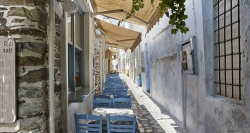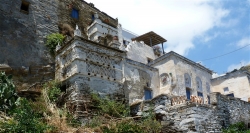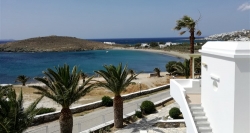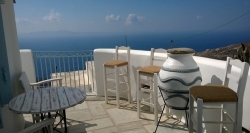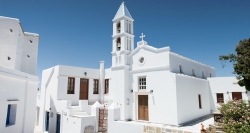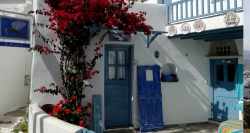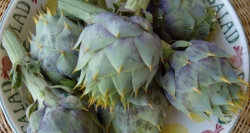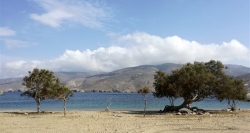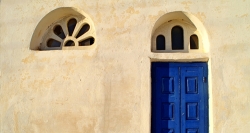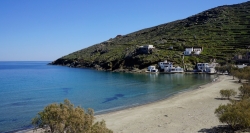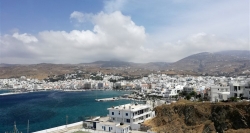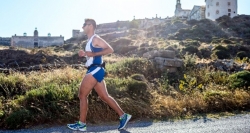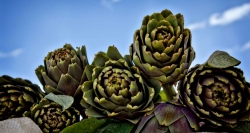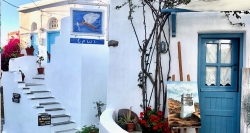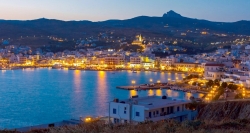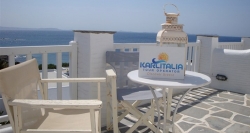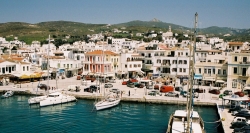Le nostre destinazioni più richieste
I nostri tour:
Common description
The pearl of the Cyclades
Tínos is one of the largest islands of the Cyclades, characterized by the typical architecture recognizable in all the villages in the area.
In recent years it has started to be discovered by travelers and has been nicknamed the "Pearl of the Aegean" for its pure and authentic charm.
Tínos has extraordinary natural beauty, around forty villages lost on the terraced slopes of the hills and numerous dovecotes scattered throughout the countryside, signs of Venetian rule.
Tínos has been able to keep its precious territory intact over the years.
That uncontaminated island still remains with mountains and valleys dotted with Orthodox and Catholic churches, with dazzling white houses and windmills, with artistic pigeon houses dating back to the Venetian era, with a unique view of the infinite blue of the Aegean. The Venetian domination, which lasted about 350 years, created the rather singular conditions why every village on the island has at least two churches, the Orthodox one and the Catholic one.
Tínos is also called the island of art and beauty due to the presence of many masterpieces of art and architecture and a subsoil rich in rare types of stone, such as white and green marble, the area's ornamental material par excellence.
The beaches of Tinos: follow our advice
In Tínos you will find dozens and dozens of beaches for all tastes with a sea that is always clear and crystalline. The longest beach is Fokas, which can also be reached on foot from Tinos City.
Around the island there are mainly coves 50-80 meters long, numerous small beaches from 200 to 500 meters. and some long beaches between 500 and 2 km in length.
Fokas is a sandy beach with pebble sections, establishments with umbrellas, taverns and a beautiful panoramic view of Mykonos and Delos. Stavros and Ag. Markos, immediately west of the capital, are ideal for an afternoon swim, sheltered from the north wind and to admire a spectacular sunset. The small church of Stavròs stands on a rock near the sea. Behind the church, you will find a small and particular tavern, where we suggest ordering the traditional meze, fresh grilled octopus and small fish accompanied by an Ouzo as an aperitif.
Kionia is a sandy beach where there are excellent taverns and offers a fantastic view of the island of Syros. Ag. Sostis, Ag. Kiriaki and Ag. Ioannis, all small beaches to the east of the capital, are coves sheltered from the north winds, with compact sand and shallow seabed, a few taverns and a few umbrellas, all with a splendid view of Mykonos.
Pachia Ammos, with dark and compact sand, with intense green-blue water and desert hills all around, is ideal for a nice swim in a suggestive environment.
And again, Santa Margherita, after the village of Potamia, the small beach of fine sand which owes its name to the small Catholic church of the same name, an ideal location for those looking for a truly peaceful place. The beach made up of pebbles of a thousand colors is Livada, reachable from the villages of Steni and Myrsini via a dirt road: the landscape you pass through is truly unique, with a stream that flows into the sea forming a small lake. Exposed to winds from the north, its sea is almost always rough with really high waves which give the environment an exotic air.
Other absolutely unmissable beaches are Kolybithra, Ag. Romanos, Ag.Petros, Ormos Giannaki, Ormos Ysternion, Mali, Panormos.
What to see and what to do in Tinos: our suggestions
• Tinos City (or Chora) is the welcoming capital of the island, the Port City, located on the southern coast of the island, with a history dating back to antiquity. The discovery of the Sacred Icon of the Madonna in 1823 was an event that shocked the recent history of the island and began a pilgrimage that still today attracts faithful from all over the Orthodox Christian world. The historic center of the city, with its picturesque alleys that branch off, is an invitation to discovery.
• On the highest peak stands the imposing Church of the Virgin Evanghelistra, covered in white marble and surrounded by the various adjacent museums. It was built after the discovery of the miraculous icon and is a true masterpiece of Cycladic architecture. The most important holiday for Tinos - and one of the most relevant in the Orthodox world - is the celebration of the Dormition of the Madonna, on August 15th. The large neo-classical building on the harbor promenade houses the Tinos Cultural Institution and there are many bars, cafes and taverns along the promenade. Along the road to the Cathedral, let yourself be enchanted by the colors of the local market.
• Unmissable are the church of Angeli Taxiarchi and the splendid beaches and coves near the town. Falatados is a splendid village with white houses, in the agricultural heart of the island. The large marble-decorated church of San Giovanni dates back to the 14th century. His feast day is September 25th.
• Volax is a beautiful village surrounded by huge rounded rocks and strange granite formations - considered a one-of-a-kind natural phenomenon. In Volax the ancient art of basket weaving is preserved and handed down.
• The village of Loutra is located in a green oasis. It houses the folklore museum and two Catholic monasteries, that of the Jesuits and that of the Ursulines.
• Kolimbithra is a large inlet with two beaches, a smaller and more sheltered one organized with sunbeds and umbrellas, and another larger one, with a pond behind it with ducks and turtles. It is a surfer's paradise for its exceptional long waves.
• Pyrgos is the old capital of the island, with the dazzling white marble of the churches and houses. The School of Fine Arts has been promoting the architectural and sculptural tradition of the island since 1955.
• Panormos is the old main port of Tinos. Ships for the transport and trade of marble left from here: today it is an unmissable tourist destination thanks to the small port with its multicolored fishing boats, taverns and fish restaurants. Nearby there are a couple of beautiful beaches to reach on foot on a dirt road.
• Isternia is a charming little village perched on the mountain. It offers spectacular views of the Cyclades and the island of Syros. Ormos is the small port, 3 km below, with a pebble and sand beach, always sheltered from the north winds.
• Tarambados is a village surrounded by numerous marble dovecotes. Each dovecote is different from the other and unique in its kind. It is the ideal place to admire ancient folk architecture.
• Monastiri, Kardiani, Livada, Triandaros, Tripotamos and Kambos Komi are other villages to discover and fall in love with.
Where it is located and how to reach Tinos
Where it is: Tínos together with Andros are the northernmost islands of the Cyclades, just 2 hours by fast ferry from the port of Rafina (30km from Athens), at the center of numerous connections between the other islands Syros, Naxos, Paros (30 -60 minutes) and very nearby Mykonos (20 minutes).
How big it is: Tínos with a surface area of 197km2 is the third largest island of the 24 islands that make up the Cyclades (Naxos and Andros are the largest); predominantly hilly, its highest peak reaches 725 meters above sea level. (Mount Tsiknias). There are 52 villages scattered across the island, which form a single municipality with approximately 10,000 inhabitants. Chora (Tinos city) is today's capital.
By plane:
Landing at Athens international airport, transfer to the port of Rafina (15km) and approximately 2 hours of navigation with fast ships or 3 hours with regular ferries (4 to 6 trips every day). Instead, landing at Mykonos airport, transfer to the port and then a 20-minute boat ride. (runs every hour).
On boat:
From Italy with embarkation in Venice, Ancona, Bari or Brindisi, you must reach Patras. About three hours by car towards Athens and then a few kilometers north to reach the port of Rafina. From this port it takes about 2 hours of navigation with fast ships or 3 hours with regular ferries. (4 to 6 trips every day).
More information, useful advice and curiosities in the travel documents that will be sent before departure.
Tínos is one of the largest islands of the Cyclades, characterized by the typical architecture recognizable in all the villages in the area.
In recent years it has started to be discovered by travelers and has been nicknamed the "Pearl of the Aegean" for its pure and authentic charm.
Tínos has extraordinary natural beauty, around forty villages lost on the terraced slopes of the hills and numerous dovecotes scattered throughout the countryside, signs of Venetian rule.
Tínos has been able to keep its precious territory intact over the years.
That uncontaminated island still remains with mountains and valleys dotted with Orthodox and Catholic churches, with dazzling white houses and windmills, with artistic pigeon houses dating back to the Venetian era, with a unique view of the infinite blue of the Aegean. The Venetian domination, which lasted about 350 years, created the rather singular conditions why every village on the island has at least two churches, the Orthodox one and the Catholic one.
Tínos is also called the island of art and beauty due to the presence of many masterpieces of art and architecture and a subsoil rich in rare types of stone, such as white and green marble, the area's ornamental material par excellence.
The beaches of Tinos: follow our advice
In Tínos you will find dozens and dozens of beaches for all tastes with a sea that is always clear and crystalline. The longest beach is Fokas, which can also be reached on foot from Tinos City.
Around the island there are mainly coves 50-80 meters long, numerous small beaches from 200 to 500 meters. and some long beaches between 500 and 2 km in length.
Fokas is a sandy beach with pebble sections, establishments with umbrellas, taverns and a beautiful panoramic view of Mykonos and Delos. Stavros and Ag. Markos, immediately west of the capital, are ideal for an afternoon swim, sheltered from the north wind and to admire a spectacular sunset. The small church of Stavròs stands on a rock near the sea. Behind the church, you will find a small and particular tavern, where we suggest ordering the traditional meze, fresh grilled octopus and small fish accompanied by an Ouzo as an aperitif.
Kionia is a sandy beach where there are excellent taverns and offers a fantastic view of the island of Syros. Ag. Sostis, Ag. Kiriaki and Ag. Ioannis, all small beaches to the east of the capital, are coves sheltered from the north winds, with compact sand and shallow seabed, a few taverns and a few umbrellas, all with a splendid view of Mykonos.
Pachia Ammos, with dark and compact sand, with intense green-blue water and desert hills all around, is ideal for a nice swim in a suggestive environment.
And again, Santa Margherita, after the village of Potamia, the small beach of fine sand which owes its name to the small Catholic church of the same name, an ideal location for those looking for a truly peaceful place. The beach made up of pebbles of a thousand colors is Livada, reachable from the villages of Steni and Myrsini via a dirt road: the landscape you pass through is truly unique, with a stream that flows into the sea forming a small lake. Exposed to winds from the north, its sea is almost always rough with really high waves which give the environment an exotic air.
Other absolutely unmissable beaches are Kolybithra, Ag. Romanos, Ag.Petros, Ormos Giannaki, Ormos Ysternion, Mali, Panormos.
What to see and what to do in Tinos: our suggestions
• Tinos City (or Chora) is the welcoming capital of the island, the Port City, located on the southern coast of the island, with a history dating back to antiquity. The discovery of the Sacred Icon of the Madonna in 1823 was an event that shocked the recent history of the island and began a pilgrimage that still today attracts faithful from all over the Orthodox Christian world. The historic center of the city, with its picturesque alleys that branch off, is an invitation to discovery.
• On the highest peak stands the imposing Church of the Virgin Evanghelistra, covered in white marble and surrounded by the various adjacent museums. It was built after the discovery of the miraculous icon and is a true masterpiece of Cycladic architecture. The most important holiday for Tinos - and one of the most relevant in the Orthodox world - is the celebration of the Dormition of the Madonna, on August 15th. The large neo-classical building on the harbor promenade houses the Tinos Cultural Institution and there are many bars, cafes and taverns along the promenade. Along the road to the Cathedral, let yourself be enchanted by the colors of the local market.
• Unmissable are the church of Angeli Taxiarchi and the splendid beaches and coves near the town. Falatados is a splendid village with white houses, in the agricultural heart of the island. The large marble-decorated church of San Giovanni dates back to the 14th century. His feast day is September 25th.
• Volax is a beautiful village surrounded by huge rounded rocks and strange granite formations - considered a one-of-a-kind natural phenomenon. In Volax the ancient art of basket weaving is preserved and handed down.
• The village of Loutra is located in a green oasis. It houses the folklore museum and two Catholic monasteries, that of the Jesuits and that of the Ursulines.
• Kolimbithra is a large inlet with two beaches, a smaller and more sheltered one organized with sunbeds and umbrellas, and another larger one, with a pond behind it with ducks and turtles. It is a surfer's paradise for its exceptional long waves.
• Pyrgos is the old capital of the island, with the dazzling white marble of the churches and houses. The School of Fine Arts has been promoting the architectural and sculptural tradition of the island since 1955.
• Panormos is the old main port of Tinos. Ships for the transport and trade of marble left from here: today it is an unmissable tourist destination thanks to the small port with its multicolored fishing boats, taverns and fish restaurants. Nearby there are a couple of beautiful beaches to reach on foot on a dirt road.
• Isternia is a charming little village perched on the mountain. It offers spectacular views of the Cyclades and the island of Syros. Ormos is the small port, 3 km below, with a pebble and sand beach, always sheltered from the north winds.
• Tarambados is a village surrounded by numerous marble dovecotes. Each dovecote is different from the other and unique in its kind. It is the ideal place to admire ancient folk architecture.
• Monastiri, Kardiani, Livada, Triandaros, Tripotamos and Kambos Komi are other villages to discover and fall in love with.
Where it is located and how to reach Tinos
Where it is: Tínos together with Andros are the northernmost islands of the Cyclades, just 2 hours by fast ferry from the port of Rafina (30km from Athens), at the center of numerous connections between the other islands Syros, Naxos, Paros (30 -60 minutes) and very nearby Mykonos (20 minutes).
How big it is: Tínos with a surface area of 197km2 is the third largest island of the 24 islands that make up the Cyclades (Naxos and Andros are the largest); predominantly hilly, its highest peak reaches 725 meters above sea level. (Mount Tsiknias). There are 52 villages scattered across the island, which form a single municipality with approximately 10,000 inhabitants. Chora (Tinos city) is today's capital.
By plane:
Landing at Athens international airport, transfer to the port of Rafina (15km) and approximately 2 hours of navigation with fast ships or 3 hours with regular ferries (4 to 6 trips every day). Instead, landing at Mykonos airport, transfer to the port and then a 20-minute boat ride. (runs every hour).
On boat:
From Italy with embarkation in Venice, Ancona, Bari or Brindisi, you must reach Patras. About three hours by car towards Athens and then a few kilometers north to reach the port of Rafina. From this port it takes about 2 hours of navigation with fast ships or 3 hours with regular ferries. (4 to 6 trips every day).
More information, useful advice and curiosities in the travel documents that will be sent before departure.

